Arriving in Mirik
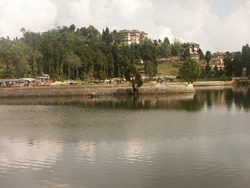 The hotel in Mirik |
The race headquarters is at the mountain resort of Mirik. Mirik is pleasant enough, and the accommodation is better than adequate. There is a “new town” near the lake – not much more than a row of shops and a couple of restaurants and hotels – which is aimed at the (largely Indian) tourist market. But further out is the old town – a bustling bazaar and market town – much more attractive and interesting than the rather artificial new area.
The highlight of Mirik, however, was the assembly of the group. These were the people we were going to be spending the next week with. It may seem like a cliche, but it is does seem to be genuinely true that it is the solidarity and cameraderie, and the shared fun, that makes a success of multi-day events like this. |
Our fellow runners came from 15 different countries, from Japan to Scotland. Many have travelled the circuit of adventure racing and multi-day running events (such as the Marathon de Sables). But many others have run nothing more than an ordinary marathon. There was, on that first night, a general nervousness in the air, as none of us knew quite what to expect of the days ahead.
Some stories of runners
Harry, a shepherd from Lockerbie, decided to run the race after reading an article in GQ Magazine two years ago. He gave up drinking and started running, while still playing squash 6 times per week and walking up and down the hills in Scotland with his dogs looking after the sheep. This trip was his first time in a plane, and first time outside the UK. (Indeed, changing planes at Heathrow was his first time in London.) He felt he haven’t done enough training, though he had been alternating 80mile and 60 mile weeks, and regularly running marathons on his own, including on a treadmill. The altitude affected him badly on the first couple of days, and he was carrying too much in his rucksack. As the week wore on, however, his strength and endurance showed, and the benefit of his training became apparent. After the event, he gave up running for good: been there, done that, and got the T-shirt.
Patrick, the writer from Texas arrived one week early and spent the time in Mirik with Mr Pandey. He thinks very positively about everything but had been deprived from talking to anyone the day we arrived. “This is maybe too much detail, but…”. Owen was suitably unimpressed when he told us a story about his wife calling up a prayer circle to help him to recover from an operation that went wrong. Pat was back to do his second Himalayan Stage Race.
Noel and Lynne were a very fit couple from Northern Ireland (which they put down as their nationality). Noel retired on medical grounds from the RUC the previous year, after 18 years in the service, at the age of 35. He was now spending all this time doing multi-day adventure races. Boy, is he tough. He ran a 100 mile race in France with Lynne in pain and had to have an operation on his return to the UK. Before arriving in India he had only run twice since the operation in August and was in the joint lead over the first three days, coming second overall.
Most of the group went to Darjeeling on 1st November, the day before the race, to sightsee. Because we had spent three days there already, we opted to stay in Mirik, running gently (to aid our acclimatisation) and relaxing. We also tried to fathom what exactly we needed to bring with us in the bags that were travelling up the mountains ahead of us the following day, and what we should leave in Mirik for our return.
DAY 1 – 24 miles – 2nd November 2003
Start: Maneybhanjang (6600 ft / 2012m)
Finish: Sandakphu (11815 ft / 3601m)
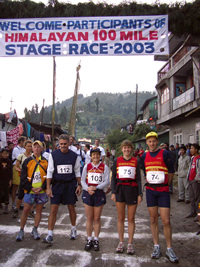 The start |
On the morning of the first day we drove in buses from Mirik to the start at Maneybhanjang, which is a small village at the start of the race. The path for the first day is essentially the border between Nepal and India, and was built in 1948 for the Aga Khan, to enable him to travel to Sandakphu, where you can see four of the five highest peaks in the world. (He never in fact made this journey; but the road is fine legacy).
After the first kilometre, the road turns uphill – which is pretty much how it stays for the rest of the way! We had been warned by Hilary, and we were expecting to walk at least the first third and last third of the 24 mile route. The road is cobbled much of the way, and very rough in places. As it happened, the three of us got up the hill together: Owen was holding back because he did not want to start too fast, and Hilary was setting an easy pace because this was only a training run for the World 100km championships the following week. We reached the first peak at Tonglu (12 km) and started the first decent. It was time for gloves and we all fought our way down the slippery cobble stones. |
Unfortunately, Hilary fell over at around 16km and broke her right ring and little fingers. We knew she is tough but perhaps didn’t realise quite how tough. After refusing to take any ibuprofen she made an emergency sling out of her spiderbag and continued until the doctor finally caught up with us at 34km. Later in the day she fell again, landing on the same hand and alreay broken fingers. For the first (and hopefully last) time, we saw here with tears in her eyes.
| We ran together for the whole of the day – walking fast up the hills, and jogging carefully down them. There is very little that is flat in between.
As the altitude increased, Owen began to suffer, and was reduced to a slow walk on the steep hairpin bends. This was clearly the effect of the rapidly increasing altitude, and seemed a worry signal about the future. The doctor – who turned out to be a tremendous asset for the whole group – caught us up near the end of the day, and very reassuringly put a splint on Hilary’s hand and gave her some pain killers. The last 4.5km were very, very steep uphill. Owen was strong during this second climb and we all finished together in 6h53. |
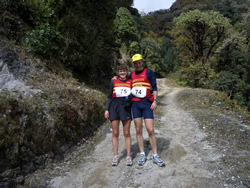 |
Sandakphu is a marvellous spot: an encampment of hikers’ huts at the top of the ridge, with marvellous views (especially at dawn – well worth getting up for). There was hot soup, snacks and hot drinks from when we arrived, and a roaring log fire to huddle round for warmth, and an excellent runners’ dinner. The huts are comfortable, but do not have electric lighting and only have cold running water (hot water is available in buckets on request: and a warm sponge never felt so good!).
One luxury was having the option to have “drop bags” left for you at any designated aid station – we just gave a bag in at the start with a tag saying which aid station we wanted it at. Sure enough: they were waiting for us. This enables you, for example, to arrange to have a warmer top waiting somewhere up the mountain, without having to carry it all the way up yourself.
DAY 2 – 20 miles – 3rd November 2003
Start: Sandakphu (11815 ft / 3601m)
Finish: Sandakphu (11815 ft / 3601m)
Today was an out and back course. This was supposed to be flat! Well, don’t believe if anyone talks about flat courses in the Himalayas. We ran together, and probably walked about a third of the day.
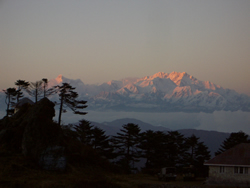 Sunrise at Sandakphu |
The hill to the turning point, Molle (11655 ft / 3540m), apparently 3km, seemed relentless. However, it was great to see the fast runners returning from the turning point. Noel and Sergio were neck and neck (even though Sergio had missed the start and had caught up with Noel.) Lynne was, for the second day in a row, amongst the fast men and finished the day as first lady (under pressure from boyfriend Noel!). She seemed unbeatable as the likely overall winner of the lady’s race.
Grethe noted in her diary: “Owen really supported me today when I felt tired with only 4km remaining (a runny tummy during the night was probably the main contributor). I am slightly worried about tomorrow’s full marathon or more according to those who have done it before.” We finished in 3 hours 53 minutes. |
DAY 3 – 26.2 miles – 4th November 2003
THE EVEREST CHALLENGE MARATHON
Start: Sandakphu (11815 ft / 3601m)
Finish: Rimbik (6350ft / 1935m)
The race started early, at 6.45am, to ensure that the slow runners and walkers had a good chance of reaching the end point before nightfall. There was still frost on the ground. We dreaded having to get up to the top of Molle (11655 ft / 3540m) again, which had been the previous day’s turning point. Somehow it seemed a lot shorter today – perhaps because we knew what to expect, perhaps because we were getting stronger, or perhaps because we were becoming acclimatised to the altitude.
We arrived at Molle after 1h43 (compared to 1h56 the day before). At around 12k, on one of the downhills, we overtook Lynne, which made Grethe the leading lady. From Molle we went further along the ridge to Phalut (11380 ft / 3469m). It was still at a high altitude, and still very undulating (which seems to be the Hindi for very hilly!)
We saw the leading men coming flying down about half way from Molle to Phulut. The road was still a mixture of rough cobble stones and hard sand. We were surprised that the stronger men were just 5-10 minutes ahead. Once we got back to Molle, the downhill began. This was fun. It began with sandy steep drops in narrow passes, and gorges, getting rougher later when we reached the woods. We could hear the waterfall long before seeing the wooden bridge. One of the runners said afterwards that he felt like Indiana Jones. After the bridge the path went along the river. Initially slightly uphill with big stones, later it was a nice even route.
Grethe noted in her diary: “But where was my energy? Owen for the first time suggested we might start to run again now it was come to a flat even road. Owen was great. He wanted me to win this race and supported me the whole way: filling my water bottle, looking back to see if we were about to be overtaken and encouraging me along.”
We finished together in 5h43, with Grethe finishing first lady and so winning the Everest Challenge Marathon.
| We finished in time to enjoy the afternoon sun at Rimbik, which was noticeably warmer than Sandakphu (partly because it was lower, but also the weather was just better that day.) The accommodation is very good here: electricity and hot showers, and the food was just as good at Sandakphu.
The behind the scenes logistics were extraordinary. Our luggage came by jeep – all the way back through Maneybhanjang, as the route of the marathon is impassable by vehicle. These did not arrive until the evening; and so porters had been arranged to bring a small bag down for each person, so that we had a change of clothes and some bare essentials between finishing the marathon and the arrival of the rest of our luggage. |
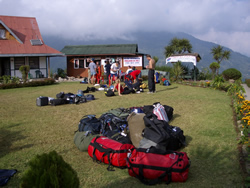 Relaxing at Rimbik |
DAY 4 – 13 miles – 5th November 2003
Start: Rimbik (6350ft / 1935m)
Finish: Palmajua (6560 ft / 2000m)
Following the marathon the previous day, and with a relatively short distance to cover on road rather than trail, we could afford to start a little later. So at 9am we assembled for the start. Everyone was feeling cheerful: the hard work was largely behind us, with 70 miles, the big climb and the marathon all behind us.
The route was steep downhill for 8km, then flat for 5km and up 1500 ft for the last 8km.
The uphill was road punctuated by hairpins through beautiful rain forest on the edge of the mountain. Lots of people were watching in front of their houses and greeting us with the traditional greeting: “Namaste”.
| Grethe walked most of the uphill, except in the sections that were flat, taking it easy after her victory in the marathon the day before; but finished third in a respectable 2:02.. Owen stormed ahead, for the first time running at his own pace. He led the race for the downhill section, but was easily overtaken by Sergio on the flat, and finished the day in joint second place, alongside Noel and Ron, in a time of 1h42.
From the finish at Palmajua, we took the bus back to Rimbik.When Mr Pandey interviewed various people in the bus at the finish we asked for the exact measurement of “Pandey-kilometers”. Yesterday was definitely longer than 42.195km which means we’ve done our first ultramarathon. |
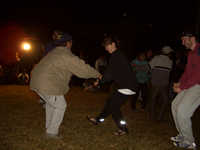 Dancing at the cultural evening |
In the evening, we had a party with the locals – singing songs from home, dancing, and dishing out some minor presents to the children.
DAY 5 – 17 miles – 6th November 2003
Start: Palmajua (6560 ft / 2000m)
Finish: Maneybhanjang (6600 ft / 2012m)
We began with a bus back to the finish of the previous day. The buses took 90 minutes – longer, in fact, than it took Sergio to run the same route the day before.
As we waited at the start, a herd of cows pushed through the runners, so we had to delay a little. We had adjusted to Indian timings (though not yet Pandey kilometres) so nobody minded.
The first 10km were a continuation of the previous day’s uphill and zizaging beautifully along the edge of the valley. Owen and I ran the first 3.5km and then ran/walked the rest of the uphill, taking photos. We were both determined not to get injured and to really enjoy our last day of running in the Himalayas. We passed some of the other participants who had been unlucky to get blisters and knee problems while running the previous 83 miles.
| We went over the peak at 8555ft. On our way down we kept on worrying about the last uphill which Hilary had warned us about. We were expecting to see her soon but didn’t catch her until about 5km to go. She didn’t feel too well but was, as usual, determined to finish. We ran in together – just the way we started. What a welcome! The local school kids were out clapping, the Darjeeling tourist minister was congratulating the finishers and a band playing. We were truly greeted in style.
The last day took us 3h05. |
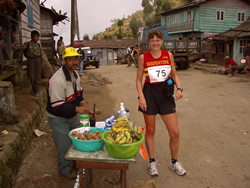 Grethe at the aid station at the top |
Lunch was laid on, followed by a bus ride back to Mirik. We had the awards ceremony, with certificates for everyone and trophies for the winners of the 100 miles and the Everest Challenge Marathon. We were all ready for dinner by the time the ceremony finished.
Our total running hours were 21h37 for Grethe, and 21h17 for Owen.